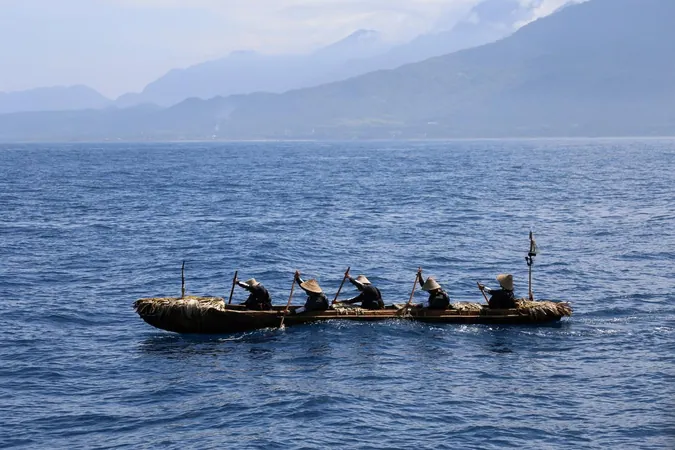
Unlocking Ancient Secrets: How Prehistoric Mariners Conquered the Open Seas
2025-06-25
Author: Yu
A Voyage into the Past
Around 300,000 years ago, our ancestors first emerged in Africa, embarking on a remarkable journey that saw them traverse the globe, reaching even the most isolated corners of our planet. But how did these early explorers conquer vast oceanic barriers with only basic tools at their disposal?
A Modern-Day Experiment on the East China Sea
Recently, a team of scientists set out on an ambitious experimental voyage across the East China Sea. Their destination? Japan’s Yonaguni Island, a trek of approximately 140 miles (225 km) from Ushibi in eastern Taiwan. Using a primitive 25-foot dugout canoe, named Sugime, the crew aimed to replicate the maritime adventures of our ancestors who likely set sail 30,000 years ago.
Recreating Prehistoric Technology
Crafted from a cedar tree harvested in Japan's Noto Peninsula, Sugime was made using authentic tools akin to those of the Paleolithic era, like axes and adzes. This hands-on approach allowed the researchers to mimic the ancient techniques that enabled early humans to build seaworthy vessels.
Facing Real Dangers: Oceans and Currents
With four men and one woman aboard, the crew navigated powerful ocean currents during a grueling 45-hour journey. Battling the notorious Kuroshio current—one of the world's strongest—the voyagers experienced extreme fatigue but successfully floated to the shores of Yonaguni after taking breaks to drift on the open sea.
Navigating Like Our Ancestors
Reflecting true ancient practices, the crew relied on the sun, stars, and observational skills to navigate, albeit with modern safety measures including two escort boats.
Learning from Failure
Previous attempts with reed and bamboo rafts had failed due to their lack of durability and speed, yet this latest endeavor opened new windows of understanding. University of Tokyo anthropologist Yousuke Kaifu stated, "Through our trials and errors, we’ve gained profound respect for our Paleolithic forebears and their oceanic skills." Despite their primitive tools, they were capable navigators with significant seamanship.
Historical Context and Ongoing Research
Archaeological findings suggest that nearly 30,000 years ago, populations fled from Taiwan towards the Ryukyu Islands, including Okinawa. But the question remained: How did they successfully make such perilous crossings? The Kuroshio, rivaling the strength of the Gulf Stream, added complexity to their voyages.
Insights from the Kon-Tiki Expedition
This research resonates with the 1947 Kon-Tiki expedition, where Norwegian explorer Thor Heyerdahl attempted a long journey by raft to demonstrate ancient transoceanic migration. While some of Heyerdahl’s theories have been contested over the years, his efforts inspired many modern explorations.
A Glimmer of Hope: Ancient Crossings Possible?
In a companion study published alongside their findings, researchers employed simulations to analyze sea conditions 30,000 years ago, confirming that navigating the powerful Kuroshio was feasible—albeit fraught with unpredictability that could have led to disastrous outcomes.
Yu-Lin Chang, a physical oceanographer involved in the study, emphasized, "Ancient peoples faced ocean conditions that were highly variable, adding layers of difficulty to their voyages. However, our simulations reveal a glimmering possibility: they accomplished what we once believed impossible." This groundbreaking research paves the way for a deeper understanding of ancient maritime capabilities and the audacity of our ancestors.




 Brasil (PT)
Brasil (PT)
 Canada (EN)
Canada (EN)
 Chile (ES)
Chile (ES)
 Česko (CS)
Česko (CS)
 대한민국 (KO)
대한민국 (KO)
 España (ES)
España (ES)
 France (FR)
France (FR)
 Hong Kong (EN)
Hong Kong (EN)
 Italia (IT)
Italia (IT)
 日本 (JA)
日本 (JA)
 Magyarország (HU)
Magyarország (HU)
 Norge (NO)
Norge (NO)
 Polska (PL)
Polska (PL)
 Schweiz (DE)
Schweiz (DE)
 Singapore (EN)
Singapore (EN)
 Sverige (SV)
Sverige (SV)
 Suomi (FI)
Suomi (FI)
 Türkiye (TR)
Türkiye (TR)
 الإمارات العربية المتحدة (AR)
الإمارات العربية المتحدة (AR)